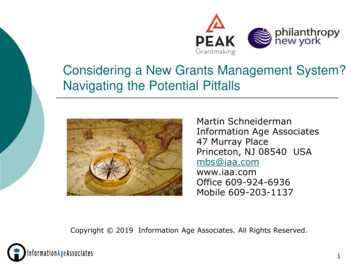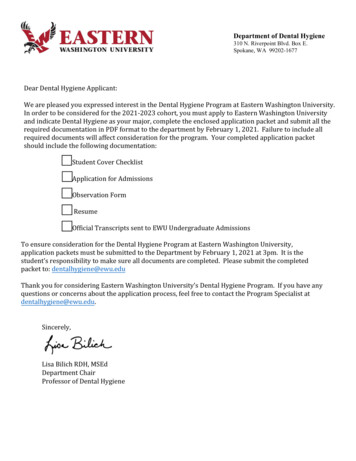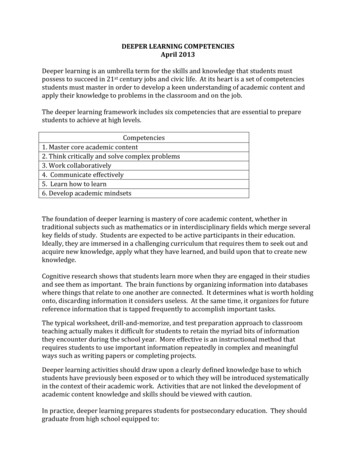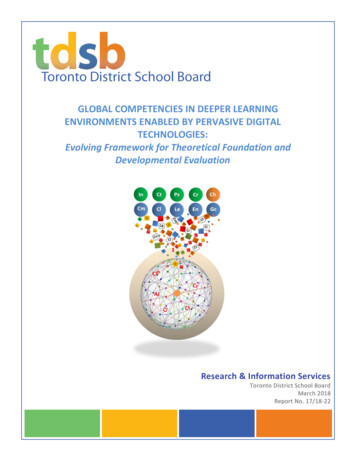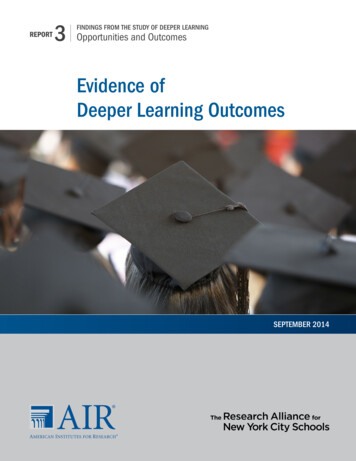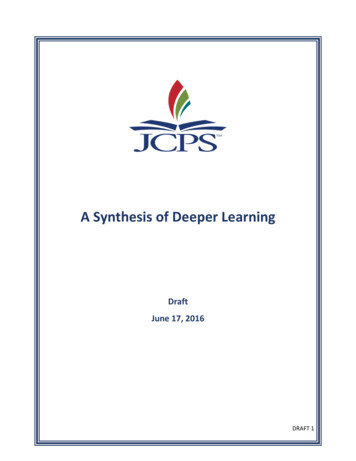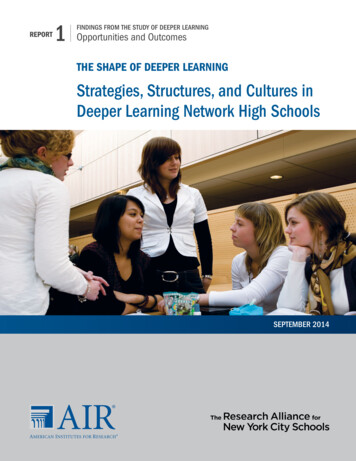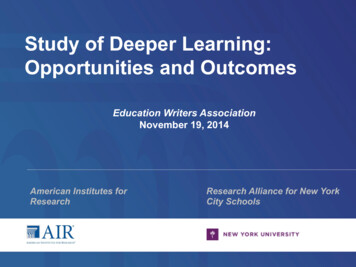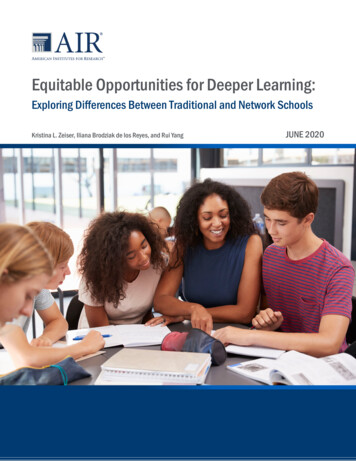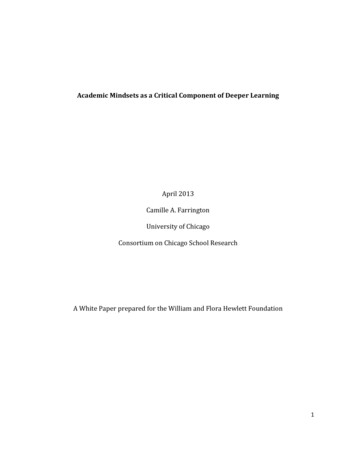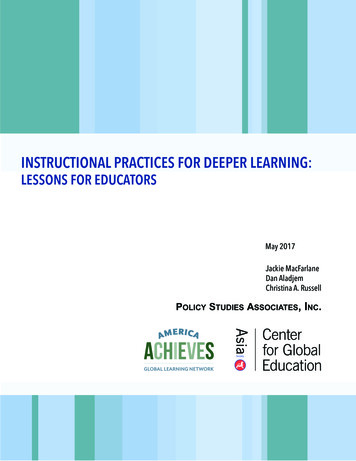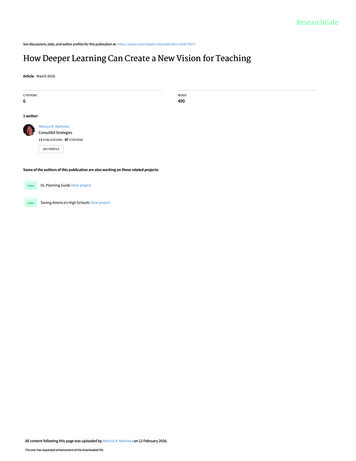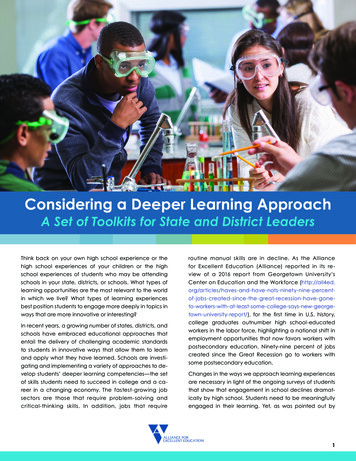
Transcription
Considering a Deeper Learning ApproachA Set of Toolkits for State and District LeadersThink back on your own high school experience or theroutine manual skills are in decline. As the Alliancehigh school experiences of your children or the highfor Excellent Education (Alliance) reported in its re-school experiences of students who may be attendingview of a 2016 report from Georgetown University’sschools in your state, districts, or schools. What types ofCenter on Education and the Work force (http://all4ed.learning opportunities are the most relevant to the percent-in which we live? What types of learning on-have-gone-best position students to engage more deeply in topics eorge-ways that are more innovative or interesting?town-university-report/), for the first time in U.S. history,In recent years, a growing number of states, districts, andschools have embraced educational approaches thatentail the delivery of challenging academic standardsto students in innovative ways that allow them to learnand apply what they have learned. Schools are investigating and implementing a variety of approaches to de-college graduates outnumber high school-educatedworkers in the labor force, highlighting a national shift inemployment opportunities that now favors workers withpostsecondary education. Ninety-nine percent of jobscreated since the Great Recession go to workers withsome postsecondary education.velop students’ deeper learning competencies—the setChanges in the ways we approach learning experiencesof skills students need to succeed in college and a ca-are necessary in light of the ongoing surveys of studentsreer in a changing economy. The fastest-growing jobthat show that engagement in school declines dramat-sectors are those that require problem-solving andically by high school. Students need to be meaningfullycritical-thinking skills. In addition, jobs that requireengaged in their learning. Yet, as was pointed out by1
the Alliance in the Deeper Learning Digest, LookingAhead With Deeper Learning head-with-deeper-learning/),the 2015 Gallup poll results show that nearly half of U.S.students report that they are not engaged or are activelydisengaged from schools.According to Governor Bob Wise, president of theAlliance, “In today’s world, twenty-first-century skill demands are steadily increasing. Most high-paying jobsrequire additional education and training beyond a highschool diploma. We must make sure that our children,particularly those who are traditionally underserved,are prepared for and have access to postsecondaryeducation.”Although the specific description of the deeper learningWhile deeper learning experiences are important for all students, researchshows schools that engage students from low-income families and minority students in deeper learning have stronger academic outcomes.zations, most definitions of deeper learning include aMoving to a Deeper LearningApproachvariation of similar abilities. Deeper learning preparesA shift to approaches that foster deeper learning in schoolscompetencies varies among educators and organi-students torequires careful consideration and planning regarding know and master core academic content;the knowledge and capacity of educators to success- think critically and solve complex problems;fully shift teaching and learning to twenty-first-century work collaboratively; communicate effectively;instructional approaches. Changes in these approachesshould respond to the need not only to change how students are learning, but also to create an infrastructure be self-directed and able to incorporate feedback;andthat routinely solicits feedback from students. Such prac- develop the academic mindsets necessary forlearning.experiences that feel more aligned with real-world issuesWhile deeper learning experiences are important forall students, research shows schools that engage students from low-income families and students of color indeeper learning have stronger academic outcomes,better attendance and student behavior, lower dropoutrates, higher graduation rates, and higher rates of college attendance and perseverance than comparisonschools serving similar students. (For more information,see the report, Graduation Advantage: Deeper LearningApproaches May Boost High School Graduation Rates,According to Updated AIR Study (http://all4ed.org/a r ticles/g raduation - advantage - deepe r- lea r n i ng ccording-to-updated-air-study/).tices ensure that the changes are resulting in learningthat students find engaging.As such, state and district leaders will need to review andconsider various policies, procedures, and practices thatlead to deeper learning competencies and outcomes.This set of toolkits defines policies, procedures, and practices as follows: Policies: A federal law, state regulation, or schoolboard rule that governs the operation of education systems and mandates educators to followspecific guidelines. Examples of federal law includethe Every Student Succeeds Act (ESSA), the HigherEducation Act (HEA), the Carl D. Perkins Careerand Technical Education Act (Perkins), and theIndividuals with Disabilities Education Act (IDEA).State regulations may include adopting new statestandards or assessments, establishing long-termgoals for the high school graduation rate, establishing new requirements for teachers and/or buildingleaders, and developing multi-tiered systems of2
Changes in the instructional approaches should respond to the need notonly to change how students are learning, but also to create an infrastructure that routinely solicits student feedback on their learning.support and evidence-based interventions forstudents. School board policies might adopt multitiered systems of support and evidence-basedinterventions; develop guidance for interim andclassroom assessments, student learning plans, orinternship opportunities; and/or regulate teacherplanning time. Procedures: A procedure describes how a state,district, or school will put a policy into action (i.e.,how the school superintendent designs the implementation strategy at the district and local schoollevel). A policy adopted at the state level may, butnot always, require a change in a policy at the district level. However, all policies require proceduresto support their implementation. If, for example, thestate moves to a multi-tiered system of support withevidence-based intervention, the district may haveto change its rules for referring students to specialeducation and devise a new system that requireseducators to use intervention and assessment datato support student learning and success prior toreferring a student to special education. If the stateadopts new college- and career-ready standards,the superintendent might design a plan to administer those standards at the district level, prepareteachers to support that work, and revisit collectivebargaining agreements to provide more teacherprofessional development. State adoption of newcomputer-based assessments may require localschool districts to review the school system’s technology infrastructure and develop a plan to trainteachers, communicate with parents, and allowstudents to practice using the technology. Practices: Practices are what educators do at thebuilding and classroom levels to implement the policies and procedures. For example, teacher leadersmay use weekly teacher planning time to meet withtheir teams to review student intervention resultsand use that information to plan lessons. Principalsmay conduct classroom observations and providefeedback to teachers on the implementation of apolicy. Students may work with teacher mentors andbusiness representatives to write their own learninggoals or determine topics and artifacts for portfolios.At events such as back-to-school nights, principalsmay inform parents and community members aboutpolicy changes, such as new learning standards orassessments.PurposeThese toolkits introduce state and district leaders to policies, procedures, and practices that may support deeperlearning outcomes. The toolkits are not designed to guideimplementation of deeper learning approaches at theclassroom level and do not provide “how to” resourcesor specific instructional strategies that teachers use intheir classrooms. These toolkits support state and districtleaders as they explore whether to launch a deeperlearning approach or move toward one; strengthen orexpand existing practices; and commit the financialresources, political support, and expertise necessary toensure success.As a leader in education policy, advocacy, and practice, the Alliance has produced numerous reports, factsheets, webinars, videos, blogs, and other resourcesabout deeper learning. These resources provide thestarting point for the toolkits. A purpose of the toolkits isto help states and districts utilize the various resources theAlliance has developed to support their work.Each toolkit contains conversation starters that stateand district leaders can use to guide discussion and/orreflection on the information presented. They provideinsights into planning, communication, and implementation issues related to launching or strengthening a deeper learning initiative. The tools themselves (e.g., discussionquestions, surveys, inventories, vignettes, etc.) assist stateand district leaders in thinking about deeper learningand having formal and/or informal conversations about3
their capacity to support a deeper learning agendathrough policies, procedures, and practices.Many organizations support and inform deeper learningwork. A listing of additional experts and advocates fordeeper learning is found in the Appendix at the end ofthis introduction.The graphic representation on page 5 shows the structureof the set of toolkits. The toolkits are organized accordingto three topic areas: understanding deeper learning; assessing deeper learning; and considering opportunitiesfor deeper learning at the high school level. There is anintroduction for each topic that sets a context for the particular toolkits for that topic area. The What and Why of Deeper Learning. The purpose of this topical area is to provide an overviewof deeper learning and its rationale. There is onetoolkit, Deepening Your Understanding of DeeperLearning, which provides state and district leaderswith basic content and information about deeperlearning. It also includes a section on equity anddeeper learning, and ways to leverage the moraland economic imperatives for deeper learning. Assessing Deeper Learning. The purpose of thistopical area is to describe policies, procedures, andpractices that support assessing deeper learningoutcomes. There are two toolkits: Using AssessmentResults, which describes the different approachesto using and communicating student assessmentdata that focuses on deeper learning outcomes;and The Every Student Succeeds Act and Assessingfor Deeper Learning, which provides a summary ofthe opportunities within the law to support a deeperlearning approach. High School Deeper Learning Opportunities. Thepurpose of this topical area is to describe policies,procedures, and practices that foster deeperlearning that are unique to high schools. There isone toolkit, Infrastructure Support, which describeshow time, space, and digital literacy can enhancedeeper learning. The district superintendent has heard about deeperlearning at conferences. Several building principalsmeet with her to consider if deeper learning mightbe a good fit in the district. After reading throughthe toolkits, the superintendent creates a committeeof district and building leaders to use the toolkits todiscuss the types of infrastructure changes necessary to launch a school improvement planninginitiative focused on deeper learning. The state leader in charge of standards andassessments wants to explore how well the stateassessments reflect deeper learning outcomes. Heforms an ad hoc team with staff members and usesthe tools and information contained in the AssessingDeeper Learning toolkits to review their assessmentprogram. They begin their conversations by prioritizing the various issues discussed in the toolkits andthen select one—ESSA and Assessing for DeeperLearning—to review in its entirety. Principals recognize the need for deeper learningpractices in their buildings. They have requestedhelp from the district leadership to expand thesepractices within their respective schools. One highschool principal focuses on the work of the English/language arts department in her building. Usingthe Deepening Your Understanding of DeeperLearning toolkit, she meets with the departmentstaff to gauge the department’s progress. The teamrecords its discussions and reviews the various toolscontained in the toolkit. The team then turns to thetoolkit in High School Deeper Learning Opportunitiesto explore additional ways to strengthen deeperlearning outcomes at their school. Once the teamhas completed its work, the principal reflects on herstaff members’ capacity to expand their work aswell as perceived buy-in to expand the work. Theprincipal uses the information collected from thesediscussions to determine next steps.These toolkits do not, of course, cover all of the issues andchallenges that states and districts must consider whenplanning policy, procedures, and practices that supportdeeper learning outcomes. The Alliance also recognizesthe vast array of documents and tools already availableUsing the Toolkitsto state and district practitioners. However, these toolkitsThe flexible design of the toolkits allows leaders to pullthey consider infrastructure issues that can support orfreely from the information and tools that best suit theirhamper a deeper learning initiative.provide state and district leaders with a starting point assituation. Consider these examples:4
Considering a Deeper Learning Approach: An Overviewof a Set of Toolkits for State and District LeadersTopic Area IntroductionThe What and Why of DeeperLearningJJ Toolkit: Deepening YourUnderstanding of Deeper Learning Blended Learning Policies,Procedures, and Practices(SDL) Connected LearningPolicies, Procedures, andPractices (SDL) Engaging Students inDeeper Learning (SDL) Inquiry-Based LearningOpportunities (SDL) Inquiry-Based LearningPolicies, Procedures, andPractices (SDL) Personalized LearningPolicies, Procedures, andPractices (SDL) Project-Based LearningPolicies, Procedures, andPractices (SDL) Reflecting on DeeperLearning Approaches andOutcomes (SDL) Work-Based InstructionPolicies, Procedures, andPractices (SDL) Work-Based LearningChallenges (SDL)Topic Area IntroductionAssessing Deeper LearningJJ Toolkit: Using Assessment Results Communicating PositivePerspectives (DL) Data Review Meetings (DL) Examples of Data Usage(SDL) Using Data Dashboards (SDL) Using Deeper LearningAssessment Results (SDL)JJ Toolkit: ESSA and Assessing forDeeper Learning Building a ComprehensiveSystem of Assessment (SDL) District Use of Portfolios,Projects, and ExtendedPerformance Tasks (DL) Interim Assessment DesignElements Checklist (DL) Learn More AboutPerformance Assessment(SDL)Topic Area IntroductionHigh School Deeper LearningOpportunitiesJJ Toolkit: Deeper LearningInfrastructure Support Digital Infrastructure: A Lookat What Districts Are Doing(SDL) Do We Have Space forDeeper Learning? (DL) Educator Capacity to UseTechnology for DeeperLearning (SDL) Making Time for TeacherProfessional Learning (DL) Opportunities in ESSA ThatSupport Digital Learning(SDL) Organizing Time for DeeperLearning (DL) Reviewing Your District’sTechnology Infrastructure(DL) Scaling Up Technology (SDL) Reviewing AssessmentComprehensiveness (DL) Sharing with BuildingLeaders (DL) Surveying Districts (SL) Using ESSA to EnhanceAssessment (SL)DL for District LeadersSL for State LeadersSDL for State and District Leaders5
Appendix: Some Experts and Advocates for Deeper LearningFollowing is a list of organizations that provide informationand resources on deeper learning. Users of the Alliance’sdeeper learning toolkit can find additional informationby visiting their websites. [Note: Information for many ofthe annotations below came from http://hewlett.org/grants/search?order field date of award&sort desc&keywords Council of Great City Schools&year &term node tid depth 1 All&program id All] Achieve is a nonpartisan education reform organization dedicated to working with states to raiseacademic standards and graduation requirements,improve assessments, and strengthen accountability. Achieve works to ensure that deeper learningoutcomes are useful and encourages states toadopt new assessment systems. http://www.achieve.org Alliance for Excellent Education is a Washington,DC-based national policy, advocacy, and practiceorganization dedicated to ensuring that all students,particularly those who are traditionally underserved,graduate from high school ready for success incollege, work, and citizenship. The Alliance hostswww.DeeperLearning4All.com, which provides educators and policymakers with information related toexpanding deeper learning opportunities as well asexamples from ten deeper learning network schools.www.all4ed.org American Institutes for Research (AIR) has conducted analyses for the Study of Deeper Learning:Opportunities and Outcomes. With that information,AIR is dedicated to determining how to updateanalyses of high school graduation rates andpostsecondary outcomes; ways in which theseoutcomes are associated with the development ofdeeper learning outcomes; and factors that facilitate/challenge implementation and sustainability.www.air.org American Youth Policy Forum is a nonpartisan organization that convenes policymakers, practitioners,and researchers to frame issues, inform policy, andcreate conversations about improving educationand young people’s lives. www.aypf.org/tag/deeper-learning/ Asia Society’s International Studies Schools Network(ISSN) is a national network of design-driven public,charter, and private schools committed to developing college-ready and globally competentgraduates. The ISSN works with school communitiesto prepare students for work and civic roles in aglobalized environment, where success increasinglyrequires deeper learning outcomes, such as collaboration, critical thinking, and teamwork. www.asiasociety.org Aspen Institute is an international nonprofit organization dedicated to fostering leadership and thepursuit of common ground. The Aspen Institute,along with the Collaborative for Academic, Social,and Emotional Learning and Civic Enterprises, isplanning a commission to promote policies thatincorporate social and emotional learning in theclassroom and communicate a policy framework toadvance critical components of deeper learning.http://www.aspeninstitute.org/education Association of Chamber of Commerce Executivessupports business engagement in education to provide opportunities for students to develop the skillsneeded to be successful in the twenty-first-centuryworkforce. The chamber fosters partnerships in highschools, colleges, and communities. www.acce.org/divisions/deeper-learning/ Beryl Buck Institute for Education creates, gathers,and shares high-quality, project-based learninginstructional practices and products and providesservices to teachers, schools, and districts. TheInstitute facilitates the creation and adoption ofproject-based learning standards that includedeeper learning outcomes. www.bie.org Business Innovatory Factory (BIF) is an organizationthat uses human-centered design to develop neweducation models. With BIF’s Student ExperienceLab, research is conducted to better understandthe issues schools face when implementing deeperlearning pract
velop students’ deeper learning competencies—the set of skills students need to succeed in college and a ca-reer in a changing economy. The fastest-growing job sectors are those that require problem-solving and
